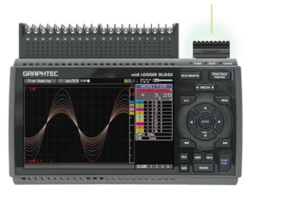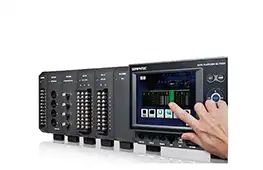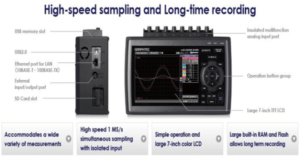
A data logger is a device that can store information. Many data collection devices, such as plug-in devices or sequential communication systems that employ a computer as a real-time data recording system, fall under this category. Wireless transmitters may now transform a standard smartphone or tablet into a mobile data loggers.
Most instrument makers, on the other hand, see a datalogger as a stand-alone device capable of reading multiple types of electrical signals and
storing the data in internal memory for subsequent transfer to a computer.
Graphtec Data loggers have the benefit of being able to function irrespective of a computer, compared to many other types of information-gathering devices. Data loggers come in a variety of forms and sizes. Simple, low-cost single-channel fixed-function recorders are available, as are more capable programmable devices capable of processing hundreds of inputs.
High-Speed Data Loggers:
 The Fast Speed Data Logger is an information storage device that allows users to capture and process data at high speeds indefinitely. The High-Speed Data Loggers is created in the style of a typical electrical cabinet or 19″ rack, but it can also be made into a durable portable 19″ box for sound professional equipment.
The Fast Speed Data Logger is an information storage device that allows users to capture and process data at high speeds indefinitely. The High-Speed Data Loggers is created in the style of a typical electrical cabinet or 19″ rack, but it can also be made into a durable portable 19″ box for sound professional equipment.
Signal conditioning, data collecting gear, a data server, and an uninterruptible power supply are among the internal components. A second cabinet can have an additional signal conversion, surge protection, and Ex protection barriers.
The goal of High-Speed Data Loggers is to capture transient phenomena that occur at unpredictable periods by recording fast channel count data at high sample rates.
The High-Speed Data Loggers is an excellent tool for diagnosing and fine-tuning rapid, large-scale continuous operations where traditional monitoring and control systems do not give adequate time resolution.
Criteria to choose a Data Logger:
The following factors to take into account while selecting a data logger:
Memory or Speed
Data loggers often have modest sample rates when compared to real-time data-collecting systems. This is usually because they store information in limited internal memory. The greater the data rate, the greater the memory needs.
As a result, while selecting a data logger, it is critical to consider the sample rate and sample duration, which may be leveraged to calculate the needed memory. As an example. If a sample rate of one per second is required for an application and the test must last one hour, the data logger ought to be able to record 3600 samples.
Size
Space is a constraint in many applications. In such instances, the size of the data logger could become an important decision factor. The high-speed data loggers series is exceptionally small and includes versions for most input sources.
Operation in Real-time
It may be desired in some applications to show the data getting collected in real-time using a computer.
Number of Inputs
Data loggers are accessible in single and multi-channel configurations. A data logger with 32 channels can handle various inputs.
Benefits of Data Loggers:
 Data loggers are often less expensive than chart recorders. They provide additional flexibility and accept a wider range of input sources. The majority of data loggers gather data that can be easily downloaded to a computer. Although this feature is available on certain recorders, it usually comes at a hefty cost.
Data loggers are often less expensive than chart recorders. They provide additional flexibility and accept a wider range of input sources. The majority of data loggers gather data that can be easily downloaded to a computer. Although this feature is available on certain recorders, it usually comes at a hefty cost.
Data acquisition systems provide a great deal of versatility and are appealing when large sample rates are necessary; but, because they require connectivity or installation into a system, the computer also needs to be present and active throughout data collection. Data loggers may capture data without the need for a computer.


